Creative Built-In Solutions to Transform Your Bedroom
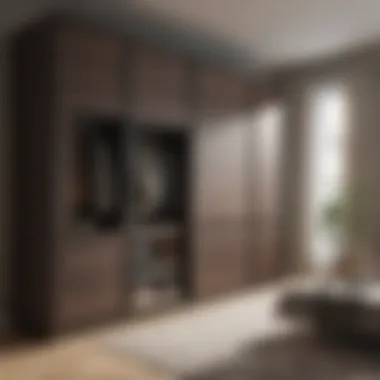
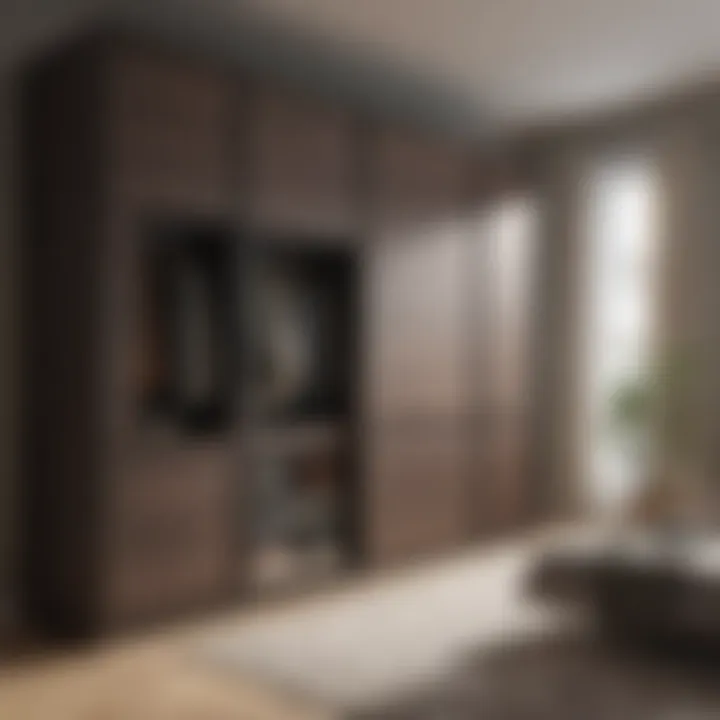
Intro
In today’s fast-paced world, the bedroom serves as more than just a space for sleep. It has evolved into a personal sanctuary where style meets functionality. The desire for innovative built-in ideas is not merely about aesthetics; it’s about creating spaces that cater to our daily needs while reflecting our personalities. As homeowners and housewives alike seek to optimize their bedrooms, understanding the current trends and visual ideas becomes crucial.
This article dives into a range of built-in elements specifically designed for bedrooms. From tailored storage solutions that keep clutter at bay to creative displays showcasing cherished items, the focus will be on how these features can transform a room into something truly special. We’ll explore trending color palettes and styles that resonate with modern sensibilities while offering practical tips and detailed examples to get the creative juices flowing.
Current Trends
When it comes to bedroom design, staying updated with current trends can breathe new life into a space. Several emerging trends are shaping how homeowners approach built-in features in their bedrooms.
Color Palettes
Colors play a significant role in setting moods and defining space. Recent trends lean towards
- Soft neutrals like beige, taupe, and muted tones, which create a serene environment.
- Earth tones such as terracotta and olive green are becoming quite popular, giving a sense of warmth and connection to nature.
- Bold accents like deep blues or forest greens lend contrast without overwhelming the senses.
These color choices not only enhance aesthetics but also work well with varied interior styles, allowing for creative customization in your bedroom.
Popular Styles
Various styles have made a mark in residential bedroom design recently:
- Scandinavian: Minimalist designs that focus on functional furniture, often finished in light colors.
- Bohemian: A mix of textures, patterns, and personalized art pieces, allowing for an eclectic touch.
- Modern farmhouse: This style incorporates rustic elements and cozy features with a contemporary twist.
With each of these styles, built-in ideas can be adapted easily to create harmonious environments that highlight individual preferences.
"A well-designed bedroom is a journey, not a destination. Every detail counts, and it's the small things that often make the biggest impact."
Visual Ideas
Visual inspiration can spark creativity, leading to various possibilities in bedroom design. Looking at styled spaces can demystify the process of integrating built-in features effectively.
Gallery of Styled Bedrooms
Consider curating a visual gallery that emphasizes different built-in ideas:
- Unique headboard designs that incorporate shelves for books or decorative items.
- Custom closets that maximize space without sacrificing accessibility, including sliding doors that save room.
- Window seats outfitted with plush cushions, offering a cozy nook for reading or relaxing.
Each of these features can add both practical use and a fresher look.
Before-and-After Transformations
Before-and-after transformations serve as compelling examples of the power of built-ins:
- Expanding tiny bedrooms with clever storage solutions that utilize vertical space effectively.
- Transforming bland walls into functional zones with integrated shelving or desk setups for work-from-home needs.
Such transformations not only provide practical solutions but also inspire ideas that readers can adapt for their own spaces.
Creating a bedroom that combines style with functionality doesn't have to be a massive undertaking. By embracing innovative built-in ideas, anyone can achieve a space that feels personal and organized. As we engage with these trends and visuals, we empower ourselves to curate the perfect sanctuary tailored to our needs and tastes.
Understanding Built-In Furniture
Built-in furniture has grown in popularity among homeowners, particularly those keen on maximizing their space and enhancing their home's overall functionality and aesthetics. The essence of built-ins lies in their seamless integration into the overall design of a room, which cultivates a polished and cohesive look that free-standing furniture often struggles to replicate. Think of built-ins as the opposite of haphazard arrangements that can lead to clutter and inefficiency. Instead, they offer tailored solutions tailored specifically for the unique constraints and demands of the space available.
Definition and Purpose
At its core, built-in furniture refers to items that are designed or constructed to be part of a specific structure. Unlike traditional furniture, which can be easily moved or replaced, built-ins are typically affixed to the walls or ceilings, creating a permanent installation.
These installations can vary widely in form, from wall-to-wall bookshelves that utilize every nook and cranny to beds with drawers beneath them, designed to liberate floor space. What’s captivating about built-ins is their potential to morph a modest room into something that feels expansive and well-organized. They’re not just about cramming in more storage; they’re about establishing a layout that embodies functionality and beauty. The purpose isn’t merely to fill empty spots but to create an inviting environment where the design speaks to the homeowner’s personality and needs.
Benefits of Built-In Solutions
The advantages of adopting built-in solutions go far beyond just aesthetics. Here are a few notable benefits:
- Maximized Space Usage: Built-ins take advantage of every inch of a room, often transforming awkward corners or walls into usable space. Instead of letting those areas go to waste, a clever-built in can convert them into functional storage or display.
- Increased Property Value: Homes with customized built-ins tend to have higher marketability. They signal to potential buyers that the space is thoughtfully designed and functional.
- Seamless Integration with the Design: Well-crafted built-ins can blend into the existing architecture, making a room feel intentional. The design flow is smooth, avoiding the visual clutter created by jumbled furniture.
- Customization Opportunities: From shelving heights to drawer depths, built-ins can be tailored to your specific needs. Whether you have a collection of rare books or a plethora of kids’ toys, a built-in solution can be designed with that in mind.
- Improved Organization: When you have designated spots for your belongings, it’s easier to keep your space clutter-free. Built-ins encourage a habit of storing items appropriately, enhancing the overall cleanliness of your bedroom.
"Embracing built-in furniture means opting for a lifestyle where harmony and functionality reign supreme."
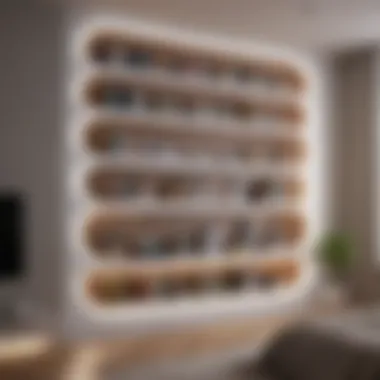
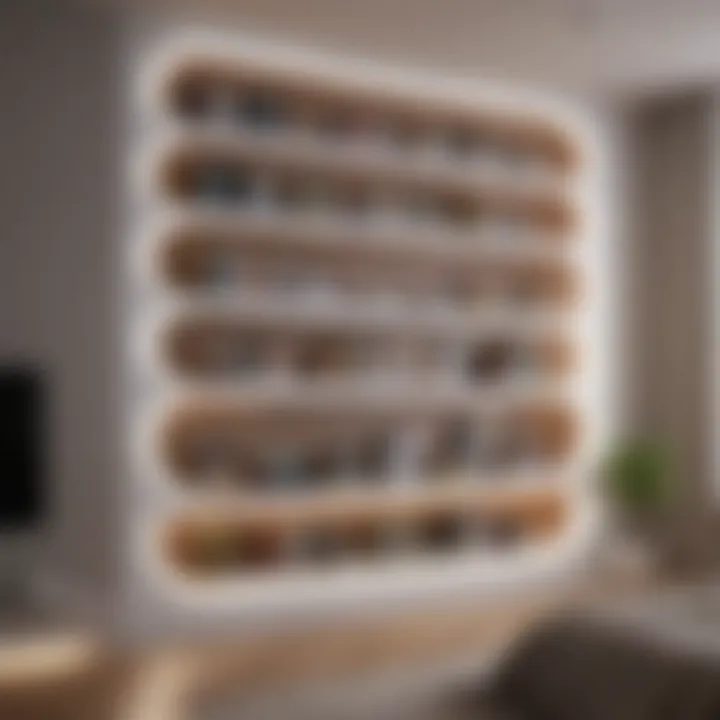
Maximizing Space with Built-Ins
When it comes to bedroom design, successfully maximizing space is paramount—especially in areas where square footage is limited. By embracing built-in furniture and design elements, homeowners can stretch their space to its limits, seamlessly blending functionality with style. Built-ins are more than just furniture; they can be transformative assets that elevate the overall utility and aesthetic of your bedroom. Whether dealing with a compact apartment or a spacious residence, the principles of maximizing space with built-ins are universally applicable and essential for creating a harmonious living environment.
Living in Small Bedrooms
Small bedrooms often come with their own set of design challenges. Instead of succumbing to the cramped feeling that can arise, consider how built-in solutions can reclaim valuable floor space. For instance, a built-in bed frame with drawers underneath can eliminate the need for separate furniture pieces, effectively minimizing clutter and maximizing storage. There’s also the option of a murphy bed, which allows for the creation of more open space during the day. In essence, the right built-in can offer a surprising amount of functionality without compromising on comfort or style.
Here are some practical ideas:
- Foldable desks: A wall-mounted desk that folds down only when needed provides a workspace without taking up permanent floor space.
- Benches with lids: A built-in window seat with storage underneath can pull double duty as an inviting nook and a clever storage solution.
- Sliding shelving units: These can keep essentials within reach while preserving a streamlined look.
Utilizing Vertical Space
Don't let precious vertical space go to waste; instead, harness its potential with built-in ideas that draw the eye upward. Vertical space is often overlooked, but it presents a tremendous opportunity for added storage and display, particularly in bedrooms where floor area is at a premium. By installing shelves close to the ceiling, you can create a stunning visual effect while keeping books and decorative items organized yet out of the way.
Consider the following:
- Tall bookcases: These can house more than just books; they can serve as showcases for cherished photographs, art pieces, or even small potted plants.
- Hanging organizers: These can be affixed to walls or the back of doors, providing smart storage solutions for accessories or smaller items.
- Wall-mounted lighting: Rather than using traditional floor lamps, think vertically with sconces that illuminate without consuming valuable space at ground level.
"A well-designed space is not just about what you see on the ground. Look up, and you'll find opportunities that can redefine your bedroom."
Types of Built-In Ideas
When it comes to enhancing bedroom spaces, built-in ideas are not just functional; they can be marvels of design that elevate aesthetics and functionality at the same time. Embracing various types of built-in solutions can help you tailor your bedroom to not just meet your needs, but to also express your personal style. From maximizing storage to incorporating multifunctional furniture, this section dives into innovative strategies that transform ordinary spaces into havens of organization and style.
Bed Frame Innovations
Integrated Storage
Integrated storage within bed frames has become a popular option for those looking to solve space challenges without sacrificing design. This concept takes advantage of the often-overlooked area beneath the bed. The key characteristic of integrated storage is the inclusion of drawers or compartments accessible from the side or foot of the bed.
The main benefit of integrated storage is its ability to keep items hidden out of sight while remaining easily accessible. For instance, winter blankets, shoes, or extra linens can be neatly tucked away, maximizing available space.
One unique feature of this storage type is the variation in design: some beds come with lift-up mattresses to access deep storage, while others integrate sleek, pull-out drawers. The disadvantage, however, can be accessibility; if your bed is too low, items stored underneath could become challenging to reach.
Adjustable Designs
Adjustable bed designs are not only about comfort but also smart utilization of space. These unique bed frames can be altered in height or configuration, adapting to the user’s preference for lounging or sleeping. A major aspect of these designs is their versatility; they cater to diverse needs, from reading in bed to accommodating guests.
What sets adjustable designs apart is their ability to offer storage solutions that can also change as per your needs. Some designs allow for removable or add-on components that can create a more tailored set up. However, they can sometimes be an investment, and not every model will fit snugly in rustic bedroom styles.
Wardrobe and Closet Solutions
Open Shelving Concepts
Open shelving concepts are making waves in the way we approach storage in bedrooms, moving away from traditional cabinetry towards a more accessible organization. These designs emphasize visibility and easy access to clothes and shoes, turning them into part of the room's décor. This characteristic presents an opportunity to display neatly folded items, thus adding a personal touch.
The major benefit of open shelving is the sense of spaciousness it induces, which can make small environments feel less cramped. Moreover, it encourages users to keep items organized and tidy. However, be mindful of dust accumulation—without doors, items can quickly gather dust, necessitating regular cleaning.
Sliding Door Options
Sliding door closets are a clever solution for bedrooms where space is at a premium. Unlike traditional swing doors, which require room to open, sliding doors glide back and forth, maintaining a sleek profile. This fundamental design element is not only stylish but incredibly practical for tight spaces.
What makes sliding doors an appealing choice is their ability to be customized; you can install mirrors or unique wood finishes to complement your room style. However, they can be a bit tricky for smaller items since accessing the full depth of the closet can require maneuvering around the sliding panels.
Multifunctional Furniture
Desks That Disguise
Desks that disguise themselves as other pieces of furniture provide an excellent opportunity for those who need a workspace without establishing a permanent fixture. Whether it’s a desk that folds into a wall or one that tucks away neatly inside a cabinet, these designs offer superb utility.
The key aspect of desks that disguise is their ability to seamlessly blend into the room's overall aesthetic while providing a functional workspace when needed. The unique feature is when these desks come with integrated storage, allowing users to eliminate clutter when the desk is stowed away. One downside might be the limited workspace available in some designs, which may not suit everyone’s needs.
Seating with Storage
Seating with built-in storage capabilities caters to the desire for both comfort and practicality. From ottomans to benches, these furniture pieces are designed to hide away belongings while offering a resting spot. The central advantage of this kind of furniture is versatility—it can serve multiple purposes, making it a smart choice for smaller bedrooms.
What sets this storage option apart is the vast range of styles available; you can find chic upholstered ottomans or rustic wooden benches, accommodating different design tastes. A potential drawback could be the weight of these pieces, especially as they fill with items; it can make them cumbersome to move around.
As you can see, exploring built-in ideas provides a wealth of possibilities for personalized and functional bedroom design. By thoughtfully considering specific solutions like those above, your bedroom can well reflect both practicality and creativity.
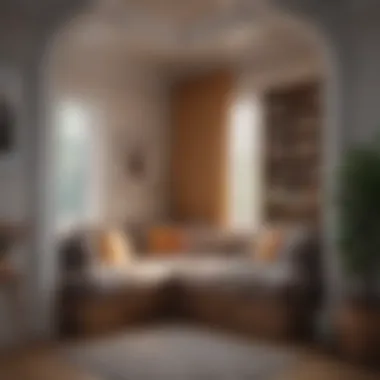
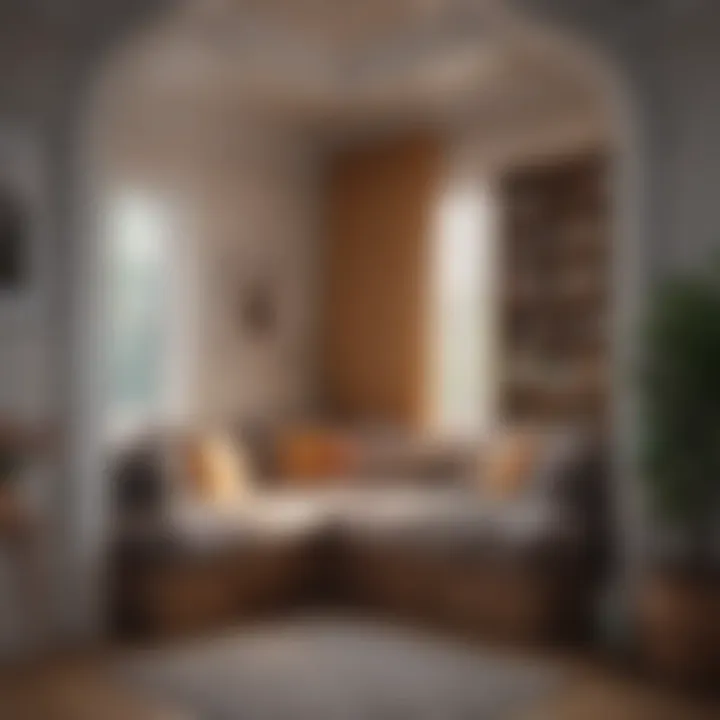
Aesthetic Considerations
Aesthetic considerations play a pivotal role when incorporating built-in furniture into a bedroom. The right design not only enhances the visual appeal but also creates an atmosphere that reflects personal style. Elegance, comfort, and functionality should coalesce to achieve a harmonious space. By considering aesthetics, one elevates the mundane utility of furniture to an art form, making every corner of the bedroom inviting and vibrant.
Material Choices
Wood vs. Metal
When thinking about material choices for built-in furniture, the debate often boils down to wood and metal. Each has distinct characteristics that can drive the overall aesthetic of the bedroom.
Wood, for instance, brings warmth and natural beauty. The grain patterns and finishes can create a sense of coziness. It's often a favored choice for those keen on maintaining a traditional vibe or a rustic charm. However, wood requires some tender loving care. It can scratch easily, and certain finishes might not hold up well in humid environments.
On the flip side, metal offers a sleek, modern touch. Think about brushed steel or matte black finishes that exude sophistication. Metal surfaces can withstand wear and tear better than wood and are relatively easy to maintain. Nonetheless, they might feel cold or industrial for some, not providing the warm embrace that wood can.
Ultimately, the decision between wood and metal should align with one's personal design vision, as both materials bring unique flavors to the table.
Eco-Friendly Options
In recent times, eco-friendly materials have gained traction among conscientious homeowners. The key characteristic here is sustainability. Eco-friendly options often include reclaimed wood, bamboo, or recycled metals.
Choosing eco-friendly materials is not only beneficial for the environment; it also adds a unique story to your space. For example, reclaimed wood comes with history, showcasing marks and imperfections that can create a rich narrative in the design.
Some eco-friendly materials, however, may not perform as robustly as their conventional counterparts. Bamboo, though stylish and sustainable, can be prone to warping if not treated properly.
Incorporating eco-friendly options into your built-in designs not only reflects a commitment to sustainability but also signals to others that aesthetics and responsibility can go hand in hand.
Color Schemes and Finishes
Now turning to color schemes and finishes, these elements dictate the overall mood of the space. The color palette can open up a room, creating illusions of space or warmth depending on the hues selected. Light colors, such as whites or pastel shades, tend to enlarge the feel of a room while darker colors give an air of intimacy.
Finish plays a crucial role in this regard as well. A high-gloss finish can bring a contemporary flair, while a matte finish often feels more subdued and natural. This combination can elevate built-ins into a design focal point or seamlessly integrate them with the surroundings.
Achieving a balanced look might involve considering how colors from decorative items, walls, and built-in systems coalesce. Subtle contrasts can visually spice up the space, ensuring it remains engaging without overwhelming one's senses.
Remember, functional design doesn’t mean one must sacrifice style. The fusion of materials, colors, and finishes can yield a space that is both practical and visually captivating.
Personalization and Customization
In the realm of bedroom design, personalization and customization stand as key pillars that can transform a simple space into a genuine reflection of one’s personality and lifestyle. Whether you are a tidy enthusiast or a collector of quirky knick-knacks, your bedroom is more than just a place to sleep; it's your sanctuary. By tailoring built-in solutions to meet your specific needs, you create functionality that harmonizes with your aesthetics. This approach not only enhances the room's appearance but also contributes to a more organized and enjoyable living environment.
Tailored Storage Solutions
Dividers and Bins
When it comes to tailoring your storage solutions, dividers and bins play a pivotal role. These organizational tools keep clutter at bay, ensuring every item has its rightful place. A notable characteristic of dividers is their versatility; they can be integrated into drawers, closets, or even shelves, allowing you to categorize everything from clothing to accessories to documents. Using dividers helps to save you from the all-too-frequent "where did I put that?" moment, making them a popular choice for anyone seeking order amidst chaos.
One unique feature of dividers is their ability to adjust based on your specific needs. For instance, many dividers come in expandable formats, which means that as your collection of belongings grows, you can simply modify the layout, rather than replacing the entire system. However, while dividers are great for small items, they can be less effective for larger objects, requiring additional considerations for their integration.
Specialty Sections for Items
Specialty sections provide an innovative twist on built-in furniture, creating designated areas tailored for particular items. This feature can include everything from pull-out racks for shoes to custom compartments for tech gadgets. This design choice is particularly beneficial for maximizing storage efficiency, as it allows you to effectively utilize every nook and cranny in your space.
The standout characteristic of specialty sections is their specificity. By dedicating space for certain items, you not only promote organization but also style. These sections can be customized in size, depth, and even color, further enhancing your bedroom’s aesthetic appeal. One disadvantage, however, might be the initial investment of time and resources to create these specialized areas, which may not be ideal for some homeowners looking for quick fixes.
Artwork and Decoration Integration
Integrating artwork and decorations into built-in solutions adds a layer of sophistication and personal touch to your bedroom. Instead of simply focusing on functionality, considering the visual appeal of your space is paramount. Custom shelves can showcase not just your beloved books but also framed photographs or captivating artworks that speak to your personality.
By weaving in decorative elements within your built-ins, you create a cohesive look that complements your room's overall theme. For example, a sleek wooden shelf could serve as a backdrop for a colorful mosaic piece, creating a dazzling contrast that draws the eye. Additionally, a carefully placed mirror within a built-in can reflect light, making the space feel larger and more inviting. By focusing on these details, you transform your suite into a unique extension of yourself—one that impressively doubles as both functional furniture and a canvas for creative expression.
DIY Built-In Projects
When it comes to crafting a personalized space in your bedroom, DIY built-in projects stand out as one of the most engaging routes to take. They offer a unique combination of creativity and practicality that can transform any corner of your room into something truly special. Not only do these projects allow you to customize storage and functionality, but they also bring a sense of accomplishment as you witness your ideas coming to life. In this section, we'll delve into some key aspects that will help guide your DIY journey, including planning your project effectively and understanding the step-by-step process involved.
Planning Your DIY Build
Assessing Your Space
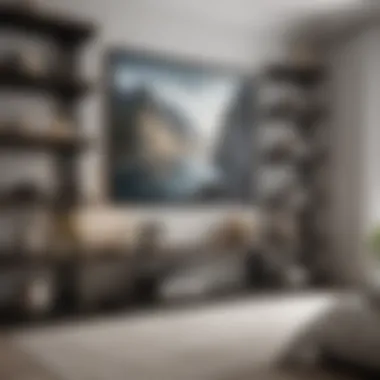

Assessing your space is the cornerstone of any successful DIY project. It involves taking a good look at what you have and what you need. One of the first things to consider is whether there are any natural features worth keeping, like windows or nooks. Measurement is crucial here; making a precise measurement allows you to visualize your project accurately. The key characteristic of assessing your space is finding both opportunities and constraints. For instance, if a wall is too small for a expansive shelving unit, a smaller, vertical unit could do wonders.
A significant benefit of this process is that it highlights areas in your room that you might overlook in day-to-day life.
"Space is not just about quantity but how we can use it effectively."
Knowing the unique features of your room helps guide your creative impulses while keeping the project feasible. On the flip side, you may discover that a particular design dream doesn't translate well to your existing layout, which is a helpful lesson to learn early on.
Gathering Materials
Once you've assessed your space, the next step is gathering materials. This process can turn from mundane to inspiring as you peruse local stores or browse online. The key characteristic of gathering materials lies in understanding both functionality and aesthetics. For example, if you're creating a bookshelves, the type of wood you choose can dramatically change the look and feel of your room.
Moreover, going for eco-friendly materials is becoming a popular choice. Reclaimed wood, for instance, not only adds character but also tells a story. This approach also offers a rewarding sense of sustainability.
A unique feature of gathering materials is that it often leads to unexpected opportunities. You might find a vintage piece that perfectly matches your decor or discover new tools that you never knew you needed. However, don’t overlook the potential downsides. Prices can vary greatly, and you might end up spending more than you initially planned if you're not careful. But, in the end, having the right materials sets the foundation for a successful project.
Step-by-Step Guides
Breaking down your DIY plan into manageable steps can make what seems daunting into something achievable. With the right strategy, even something as ambitious as a built-in wardrobe can be divided into clear stages:
- Draft a Blueprint: Start with sketches that show dimensions and placements.
- Calculate Your Budget: Estimate the costs for materials and tools. Be realistic.
- Prepare the Area: Clear the workspace, and ensure all necessary tools are at hand.
- Build in Stages: Don't rush. Take each component one step at a time, ensuring accuracy along the way.
- Finishing Touches: Once built, assess and add decoration or finishing treatments as you see fit.
Each of these steps contributes to a feeling of satisfaction and ownership over the final product. Understanding how to break your task into those manageable pieces is paramount; it changes the daunting into an achievable journey.
Professional Installation: When to Call an Expert
When considering built-in furniture for your bedroom, it’s essential to recognize that the installation phase can make or break your home's aesthetic and functionality. While some projects may seem straightforward, certain built-in ideas often require a level of finesse and expertise that goes beyond the average DIY scope. This section sheds light on why enlisting a professional's help could be beneficial, along with key factors to keep in mind.
Assessing Complexity
Not every built-in project demands professional intervention, but knowing when to admit that your own skills may not cut it is crucial. Start by assessing the complexity of the installation:
- Project Size: A massive wall-to-wall unit will likely involve more challenges than a simple shelf installation. More pieces and greater heights mean more potential for costly errors.
- Technical Skills Required: If your project involves electrical work, like built-in lighting, it is wise to consult an expert. These installations can pose significant safety risks if not handled correctly.
- Tools Necessary: Do you have the tools needed for the job? Some setups might require specialized equipment. If you find yourself heading to the tool rental store more than once, it may be cheaper to hire a professional.
- Structural Integrity: Built-ins often require alterations to existing structures. If you're not confident assessing load-bearing walls or floor stability, it's best to leave it to a pro.
In short, if the project begins to resemble a Rubik's Cube, experts may be your best solution.
Costs and Considerations
Deciding to bring in experts for installation does include an added expense, and knowing what to expect can help you avoid sticker shock. Here’s a breakdown of factors affecting costs:
- Labor Charges: Most professionals will charge by the hour. Depending on where you live, rates can vary. On average, you might be looking at between $50 to $150 per hour.
- Material Costs: In some cases, the installer might also source materials. This can add to the overall bill, especially if they opt for higher-end materials that you wouldn't have considered otherwise.
- Travel Fees: If your project is more remote, don’t overlook potential travel fees. Installers might charge extra for long distances.
- Time Estimates: A smaller job might take a professional two or three hours, while more extensive projects can stretch over several days. This is particularly true for custom installations that require multiple fittings or adjustments.
- Warranty Options: Hiring a professional may also provide you with warranty benefits. Good professionals will often guarantee their work, which can save you money in future repairs or adjustments.
Just as you wouldn’t call a plumber for electrical work, hiring the right kind of expert for your specific built-in project is crucial.
"A penny saved is a penny earned," but in this case, choosing quality installation might just be worth the extra dimes spent.
Keeping It Stylish and Functional
A bedroom should be more than just a place to lay your head; it ought to be a sanctuary where comfort meets style. The balance of aesthetics and practicality plays a crucial role in any built-in design. In Keeping It Stylish and Functional, we aim to showcase how innovative built-in ideas can elevate your bedroom, making it both visually appealing and highly effective in its use of space.
When considering built-in solutions, it’s essential to think holistically about your design choices. Each element should complement the overall vibe of the room, providing a cohesive feel. Here are a couple of thoughts:
- Functionality First: Built-in furniture should serve its purpose efficiently, whether it's a bed with hidden storage or shelves that fit snugly into an awkward corner. You want the pieces to work for you, not against your sense of style.
- Stylish Touches: While function is paramount, the visual aspect shouldn’t be overlooked. Finishes, colors, and materials can greatly enhance the room's ambiance. If done right, built-in features can turn a simple bedroom into a sophisticated retreat.
By utilizing innovative designs, homeowners can create spaces that are not only practical but also reflect their personal taste. The beauty of this approach is that it allows for a high degree of customization, ensuring that the bedroom remains a true reflection of your personality.
"Style is a way to say who you are without having to speak." – Rachel Zoe
Maintenance Tips for Built-Ins
Maintaining built-in furniture isn’t just about wiping down the surfaces now and then. To keep your styles looking fresh and stylish, a few consistent practices can go a long way:
- Regular Cleaning: Dust and dirt can accumulate quickly, especially in the hidden nooks of built-ins. Employ a gentle cleaner suitable for your materials, whether it’s wood, metal or otherwise. A soft cloth and mild soap can do wonders.
- Check for Wear and Tear: As with any furniture, built-ins face wear over time. Frequent checks can help pinpoint issues sooner rather than later, be it a loose hinge on a cabinet door or a slight dent in a panel.
- Stay Organized: An organized space is a happy space. Regularly reassessing what’s inside your built-ins ensures they function properly and stay aesthetically pleasing. Consider using dividers or bins to maintain order.
Implementing these simple maintenance practices can prevent larger issues down the road, solidifying both the style and functionality of your built-in solutions.
Evolving Your Space Over Time
As life changes, so do our needs within a living space. One of the most significant advantages of built-in furniture is its adaptability. Creating a bedroom that grows along with you is of utmost importance. Here are some ideas:
- Versatile Furniture: Consider built-ins that can transition into other uses. For example, a daybed can easily change function from a sleep space to a lounging area for daytime reading.
- Adjustable Designs: Opt for designs that can be easily modified. Incorporate shelves and compartments that can shift in size, giving you the option to adapt the storage and display depending on the number of items you have.
- Seasonal Updates: Sometimes subtle changes can refresh a built-in piece. Swapping out decor, using seasonal colors, or changing the textiles incorporated into the built-ins can make a significant difference without a complete overhaul.
By planning for the future while building, one can ensure the bedroom space remains stylish and functional. Built-in designs not only improve the current aesthetic but also create a vision for how your personal space can evolve into your ideal living environment.
Adapting built-ins to your lifestyle ultimately means creating an area that sustains your evolving needs, ensuring that it remains a comforting place through the changes life brings.



